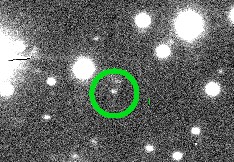Narvi (moon)
 Narvi's discovery image | |
| Discovery | |
|---|---|
| Discovered by | Scott S. Sheppard et al. |
| Discovery date | 11 April 2003 |
| Designations | |
| Pronunciation | /ˈnɑːrvi/ |
Named after | Narfi |
| S/2003 S 1 | |
| Orbital characteristics[1] | |
| 19226600 km | |
| Eccentricity | 0.2990 |
| −995.33 days | |
| Inclination | 136.803° |
| Satellite of | Saturn |
| Group | Norse group |
| Physical characteristics[2] | |
| 3.5+50% −30% km | |
| 10.21±0.02 h | |
| Albedo | 0.06 (assumed) |
Spectral type | g – r = 0.24 ± 0.07, r – i = 0.42 ± 0.09[3] |
| 23.8 | |
Narvi /ˈnɑːrvi/ or Saturn XXXI is a natural satellite of Saturn. It was discovered by a team of astronomers led by Scott S. Sheppard in 2003, and given the temporary designation S/2003 S 1.
Description
[edit]Narvi is about 7 kilometres in diameter, and orbits Saturn at an average distance of 19,371,000 km in 1006.541 days, at an inclination of 136.8° to the ecliptic (109° to Saturn's equator), in a retrograde direction and with an eccentricity of 0.2990, very similar to Bestla's orbit.[4] Narvi's rotation period is 10.21±0.02 hours, and its light curve has three minima like Siarnaq and Ymir. Unlike the other triangular moons, however, one minimum is much higher than the others, and the maximum that is a half-period ahead is much lower.[2]
Naming
[edit]It was named in January 2005 after Narfi, a giant in Norse mythology. The name was approved by the IAU Working Group on Planetary System Nomenclature on 21 January 2005.
References
[edit]- ^ S.S. Sheppard (2019), Moons of Saturn, Carnegie Science, on line
- ^ a b Denk, T.; Mottola, S. (2019). Cassini Observations of Saturn's Irregular Moons (PDF). 50th Lunar and Planetary Science Conference. Lunar and Planetary Institute.
- ^ Peña, José; Fuentes, Cesar (2022-05-17). "Colors of Irregular Satellites of Saturn with the Dark Energy Camera". The Astronomical Journal. 163 (6): 274. arXiv:2204.08391. Bibcode:2022AJ....163..274P. doi:10.3847/1538-3881/ac6258. ISSN 1538-3881.
- ^ Denk, T.; Mottola, S.; Bottke, W. F.; Hamilton, D. P. (2018). "The Irregular Satellites of Saturn". Enceladus and the Icy Moons of Saturn (PDF). Vol. 322. University of Arizona Press. pp. 409–434. Bibcode:2018eims.book..409D. doi:10.2458/azu_uapress_9780816537075-ch020. ISBN 9780816537488.
External links
[edit]- IAU Working Group for Planetary System Nomenclature
- IAUC 8116: Satellites of Jupiter and Saturn Archived 2006-05-05 at the Wayback Machine April 11, 2003 (discovery)
- MPEC 2003-G39: S/2003 S 1 April 8, 2003 (discovery and ephemeris)
- IAUC 8471: Satellites of Saturn January 21, 2005 (naming the moon)
